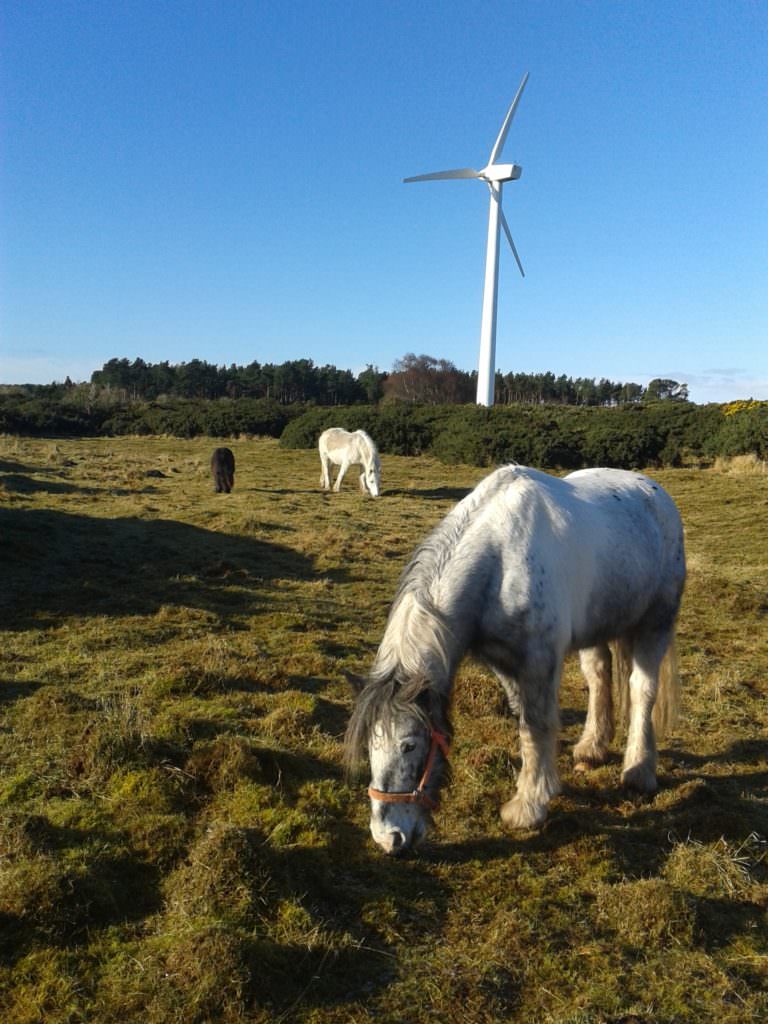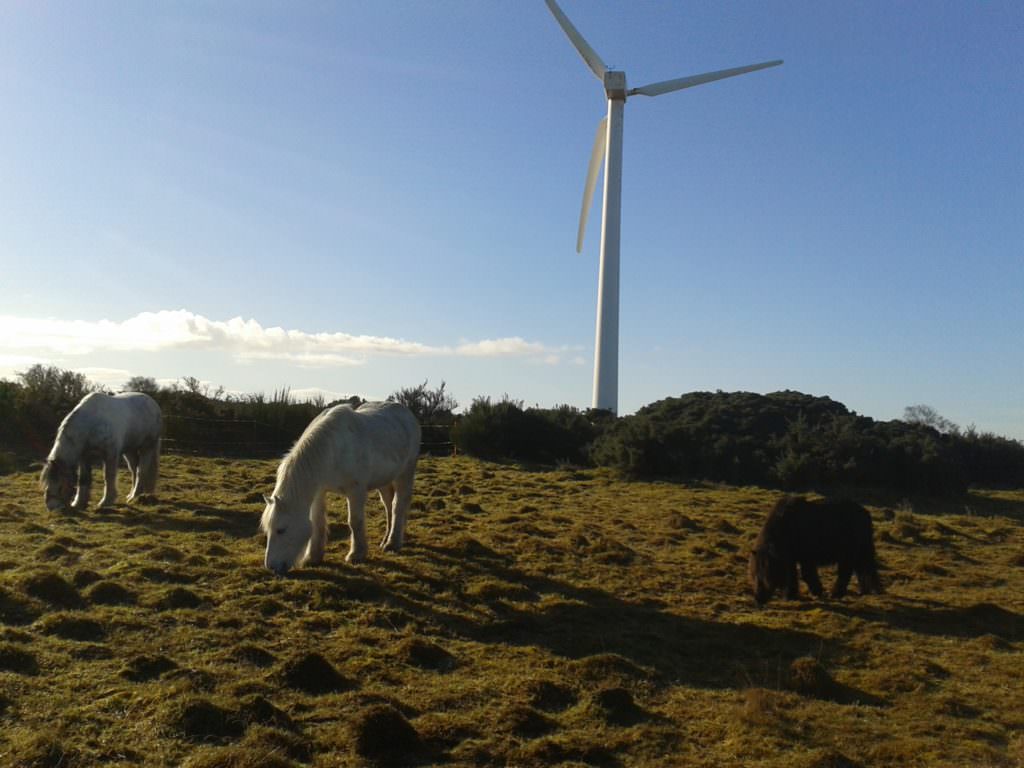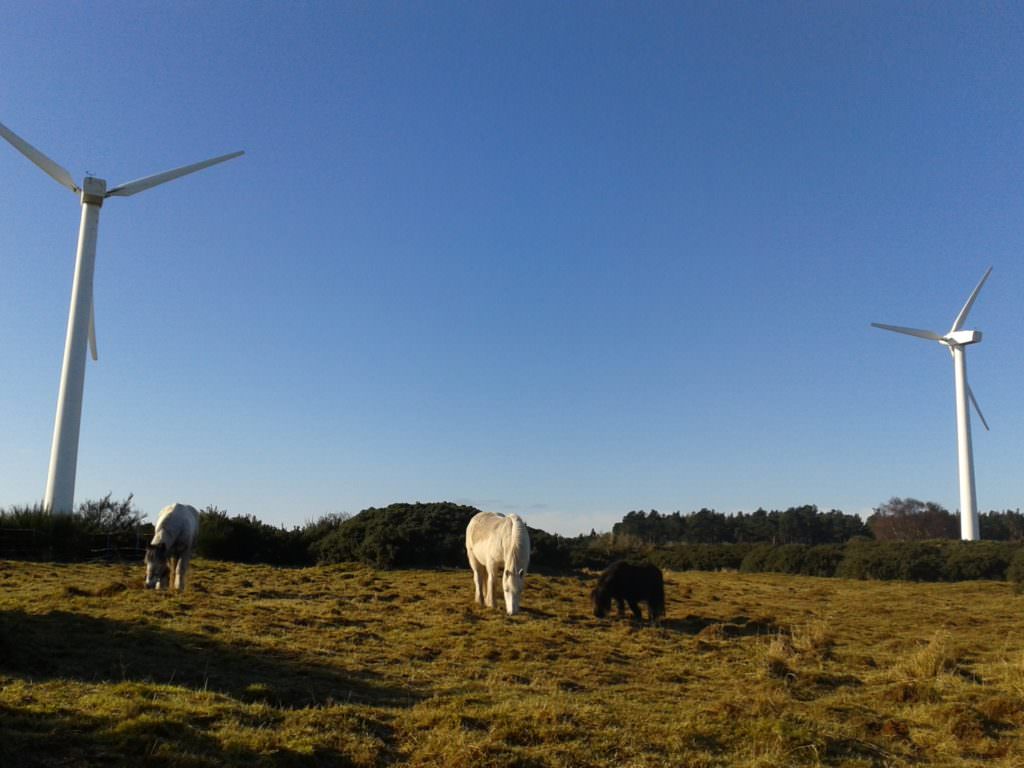Greetings from the pony field, especially from Jock who joined last April and has enjoyed the last 10 months of exploring and making friends. Jock is an Appaloosa cob/Irish draft pony and was living and working at a riding school until he developed back issues and had to take early retirement from riding. The Hinterland pony field has been really good for him, keeping him fit and full of interest in life. The two resident ponies have generously allowed him to join their herd and change their dynamics and routines.

At the time of writing in the middle of February we are in our winter routine of what is recommended as managed grazing in Hinterland’s Biodiversity Action Plan: every day the ponies go out to spend a good few hours on various areas of dune grassland around the wind turbines, keeping the grass short for a number of species of summer flowers, birds and insects. They are real experts, and deal with the grass efficiently and quickly. If you look around, you will see where they have been this winter as it looks so tidy. Moving ponies between fields twice a day is always an exciting moment, as they are always keen to go out and also keen to come back for their dinner.
On the human side I have enjoyed the many people walking past, saying hello and taking an interest in the ponies and in the land. A special delight are Fiona and her group of toddlers who always stop to see the ponies.

Of course it is very tempting to want to stroke a pony, and if Jock is at the gate I often let him decide if he wants to be stroked (he used to be part of the local RDA (Riding for the Disabled) team and is quite safe with younger people). It is also tempting to want to give them treats, but this is actually not safe: apart from some treats not being suitable, ponies might learn to snatch treats, to lean on the fence if you hold out the treat, or fight over it when it is thrown over the fence for them.
Winter in the field might look rough to us humans, but from a pony perspective is more fun than being in a stable. Native ponies develop a thick coat that acts as an insulation layer that may have snow on top but is toasty warm inside. Jock is wearing a rug right now because that is what he has been used to, he has already become much more woolly but it might take him a couple of years to get to full winter weather capacity. And all through the winter we’ve had new growth and flowers on the gorse! Both are a favourite with the ponies, and they manage to munch even the prickly bits.
Late winter might also be a good time for gardeners to get manure from us before all the other spring tasks begin in the garden, to either mix into your compost heaps or to mulch around your trees and shrubs. If you would like some happy pony manure contact Kathryn Kusa either on 01309 690712 or [email protected]
Katharina Kroeber, February 2022

















Greetings from the Pony Field
Greetings from the pony field, especially from Jock who joined last April and has enjoyed the last 10 months of exploring and making friends. Jock is an Appaloosa cob/Irish draft pony and was living and working at a riding school until he developed back issues and had to take early retirement from riding. The Hinterland pony field has been really good for him, keeping him fit and full of interest in life. The two resident ponies have generously allowed him to join their herd and change their dynamics and routines.
At the time of writing in the middle of February we are in our winter routine of what is recommended as managed grazing in Hinterland’s Biodiversity Action Plan: every day the ponies go out to spend a good few hours on various areas of dune grassland around the wind turbines, keeping the grass short for a number of species of summer flowers, birds and insects. They are real experts, and deal with the grass efficiently and quickly. If you look around, you will see where they have been this winter as it looks so tidy. Moving ponies between fields twice a day is always an exciting moment, as they are always keen to go out and also keen to come back for their dinner.
On the human side I have enjoyed the many people walking past, saying hello and taking an interest in the ponies and in the land. A special delight are Fiona and her group of toddlers who always stop to see the ponies.
Of course it is very tempting to want to stroke a pony, and if Jock is at the gate I often let him decide if he wants to be stroked (he used to be part of the local RDA (Riding for the Disabled) team and is quite safe with younger people). It is also tempting to want to give them treats, but this is actually not safe: apart from some treats not being suitable, ponies might learn to snatch treats, to lean on the fence if you hold out the treat, or fight over it when it is thrown over the fence for them.
Winter in the field might look rough to us humans, but from a pony perspective is more fun than being in a stable. Native ponies develop a thick coat that acts as an insulation layer that may have snow on top but is toasty warm inside. Jock is wearing a rug right now because that is what he has been used to, he has already become much more woolly but it might take him a couple of years to get to full winter weather capacity. And all through the winter we’ve had new growth and flowers on the gorse! Both are a favourite with the ponies, and they manage to munch even the prickly bits.
Late winter might also be a good time for gardeners to get manure from us before all the other spring tasks begin in the garden, to either mix into your compost heaps or to mulch around your trees and shrubs. If you would like some happy pony manure contact Kathryn Kusa either on 01309 690712 or [email protected]
Katharina Kroeber, February 2022